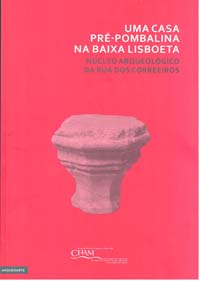Uma casa pré-pombalina na Baixa lisboeta. Núcleo arqueológico da Rua dos Correeiros

This book deals with an instant. In a moment, on the morning of November 1st 1755, a city, Lisbon, as its inhabitants knew it, vanished. As always happens with a snapshot, the space, the shapes, the objects portrayed take us back to a much longer time, to the historical process that produced and shaped them. In this case, we glimpse aspects of an urban space that was formed, changed, existed, between the 16th century and that mid-18th century day.
On the other hand, this book aims at understanding and explaining fragments. Fragments of urbanism, architectural fragments, fragments of ceramic objects. In the case of archaeological studies, the aim is to discuss a pre-existing historical discourse, sometimes confirming it, sometimes contradicting it on the basis of material clues whose contextualisation and interpretation foster the construction of knowledge. In the 16th century, the Baixa area of Lisbon underwent profound changes aimed at transforming it into the new urban centre. The city, with a millennia-old layout, was enriched and ennobled, without losing its pre-existing popular character, closely linked to several industrial-artisanal manufactures and to trade.
This city spans three centuries. The urban re-construction fostered after 1755 camouflaged its remains and completely changed its visible face and topography. Therefore, Lisbon's present-day Baixa Pombalina hides this simultaneously mythical and real object, a lost city, only accessible through History and Archaeology.
Uma casa pré-pombalina na Baixa lisboeta., Núcleo arqueológico da Rua dos Correeiros, Jacinta Bugalhão (coord.), Lisboa: CHAM, 2015, 91p., (Colecção ArqueoArte, 2).
ISBN
978988492302







